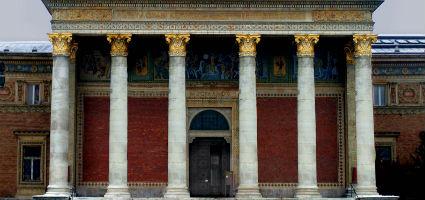2024. September 16. Monday
Kunsthalle - Budapest
 |
Address: 1146, Budapest Dózsa György út 37.
Phone number: (1) 460-7000, (1) 363-2671
E-mail: info@mucsarnok.hu
Opening hours: Tue-Wed 10-18, Thu 12-20, Fri-Sun 10-18
|
2024.06.14. - 2024.08.25.
Museum tickets, service costs:
|
Ticket for adults
|
1200 HUF
|
|
|
Ticket for adults
(valid for the Kunsthalle and the Ernst Museum)
|
1400 HUF
|
|
|
Group ticket for adults
(from over 10 people)
|
800 HUF
|
/ capita
|
|
Ticket for students
(EU citizens from the age of 6 to 26 )
|
600 HUF
|
|
|
Ticket for students
(valid for the Kunsthalle and the Ernst Museum, 6-26 years of age)
|
700 HUF
|
|
|
Group ticket for students
(from over 10 people)
|
400 HUF
|
/ capita
|
|
Ticket for pensioners
(valid for the Kunsthalle and the Ernst Museum, 62-70 years of age)
|
700 HUF
|
|
|
Ticket for pensioners
(EU citizens from the age of 62 to 70)
|
600 HUF
|
|
|
Ticket for families
(1 adults + 2 children)
|
1800 HUF
|
/ family
|
|
Ticket for families
(2 adults + 2 children)
|
2400 HUF
|
/ family
|
Antal Vásárhelyi’s fictitious, sacred or secret spaces and compositions simultaneously reveal the perfect forms of nature and geometry, wholeness and detail, thus modelling the universe. His pure structures are constructed with rigorous, engineering precision. In his spatially segmented, perfectly designed symmetrical canvases and graphic works, he adopts the rules of the golden ratio to create harmony, representing eternal values.

Using unique techniques, Vásárhelyi creates compositions with architectural plans shown from above or inside as well as depths, heights and various dimensions, these elements often being superimposed. The spaces presented from different perspectives, the stairs, ramps, pyramids, vaults, domes, windows and doors leading into the void yet guiding us to the universe are endowed with rich symbolism, opening up ever-newer realms of interpretation. The door is the passage between worlds, between light and dark, the beginning of immersing ourselves in knowledge, also evoking initiation rites: systems composed of Plato’s regular, ideal forms – the square, the circle and the isosceles triangle – and the ideal bodies created from them represent the order of the Universe and signify the divine attribute inherent in the representation of sacred spaces. The Creator, drawn with a compass and a ruler simultaneously creates and organises, while designing and shaping the Universe. The religious symbols typical of sacred spaces appear together in Vásárhelyi’s paintings and graphic pieces, lending importance to unity inherent in difference, the various states of existence, the symbols of life and death, as well as the higher and lower realms. The plans of the often surreal spaces in these works are simultaneously fictitious and idealised, but their perspectival representation always bears the element of the real.
The Műcsarnok exhibition primarily presents a selection from Vásárhelyi’s series Sacred Spaces, Interior Architecture, Architecture of Rome and Space Architecture. The architectural structures in his works rhyme with the exhibits of the Műcsarnok’s currently ongoing 3rd Salon of Architecture as well as with its satellite shows, presenting the oeuvres of György Csete and Károly Kós.

Using unique techniques, Vásárhelyi creates compositions with architectural plans shown from above or inside as well as depths, heights and various dimensions, these elements often being superimposed. The spaces presented from different perspectives, the stairs, ramps, pyramids, vaults, domes, windows and doors leading into the void yet guiding us to the universe are endowed with rich symbolism, opening up ever-newer realms of interpretation. The door is the passage between worlds, between light and dark, the beginning of immersing ourselves in knowledge, also evoking initiation rites: systems composed of Plato’s regular, ideal forms – the square, the circle and the isosceles triangle – and the ideal bodies created from them represent the order of the Universe and signify the divine attribute inherent in the representation of sacred spaces. The Creator, drawn with a compass and a ruler simultaneously creates and organises, while designing and shaping the Universe. The religious symbols typical of sacred spaces appear together in Vásárhelyi’s paintings and graphic pieces, lending importance to unity inherent in difference, the various states of existence, the symbols of life and death, as well as the higher and lower realms. The plans of the often surreal spaces in these works are simultaneously fictitious and idealised, but their perspectival representation always bears the element of the real.
The Műcsarnok exhibition primarily presents a selection from Vásárhelyi’s series Sacred Spaces, Interior Architecture, Architecture of Rome and Space Architecture. The architectural structures in his works rhyme with the exhibits of the Műcsarnok’s currently ongoing 3rd Salon of Architecture as well as with its satellite shows, presenting the oeuvres of György Csete and Károly Kós.



